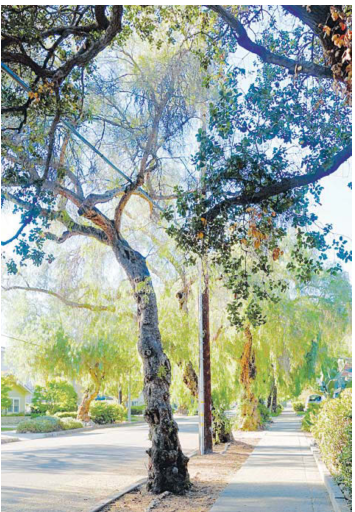
I see the causalities mounting up along my morning walk. Sycamores, sequoias, crepe myrtles, birches, flowering plums and many other established and young landscape trees are dying in the drought.
Parkway trees are being neglected by localities that planted them and the homeowners who have the responsibility to water them. Many homeowners who have replaced lawns for drought tolerant landscaping have forgotten about the trees on the property and their watering needs.
The look of our leafy suburban neighborhoods will change very quickly if trees are left to die in the drought.
Trees, unlike lawns and shrubs, are not easily replaced once gone. They take years to grow and mature into the beautiful suburban canopy we now enjoy. Do your part and encourage neighbors to keep their trees alive to preserve everyone’s property values.
A tree’s health depends on adequate irrigation, and without it the tree becomes stressed and more susceptible to disease and insects.
What can you do? Don’t cut trees off cold turkey when moving to drought tolerant landscape. Start by watering trees once every two weeks, then try once every three weeks until you reach a maintenance level of once a month.
Keep an eye on signs of stress to prevent irreversible damage. Check broadleaf trees for yellow, curling or brown-edged leaves. Are pine or spruce trees turning brown and dropping needles? Drought-stress will begin with dropping leaves but eventually destroy the branches.
One of the majestic liquid amber trees in my neighborhood, which normally heralds Fall with a glorious display of golden leaves, just dropped half of its still green leaves – a tree’s natural defense to create its own mulch. These drought stressed trees may not survive another year or more of below average rainfall and need our help now.
If
possible, consider installing a drip irrigation system or buy an
“inline emitter hose” found at home improvement stores. Start about
halfway from the trunk and spiral the hose outward, forming concentric
circles beyond the drip line.
Deep watering once
a month should be sufficient for mature trees, but young trees will
require more frequent watering every seven to 14 days, depending on
weather conditions. Citrus trees should be deep watered down to 36
inches if possible every two weeks. Check soil moisture six to 8 inches
below the surface and water if dry.
Adriana Donofrio Podley Properties Glendora (626) 926-9700 adrianad@podley.com